Key in a search term below to search our website.
Key in a search term below to search our website.
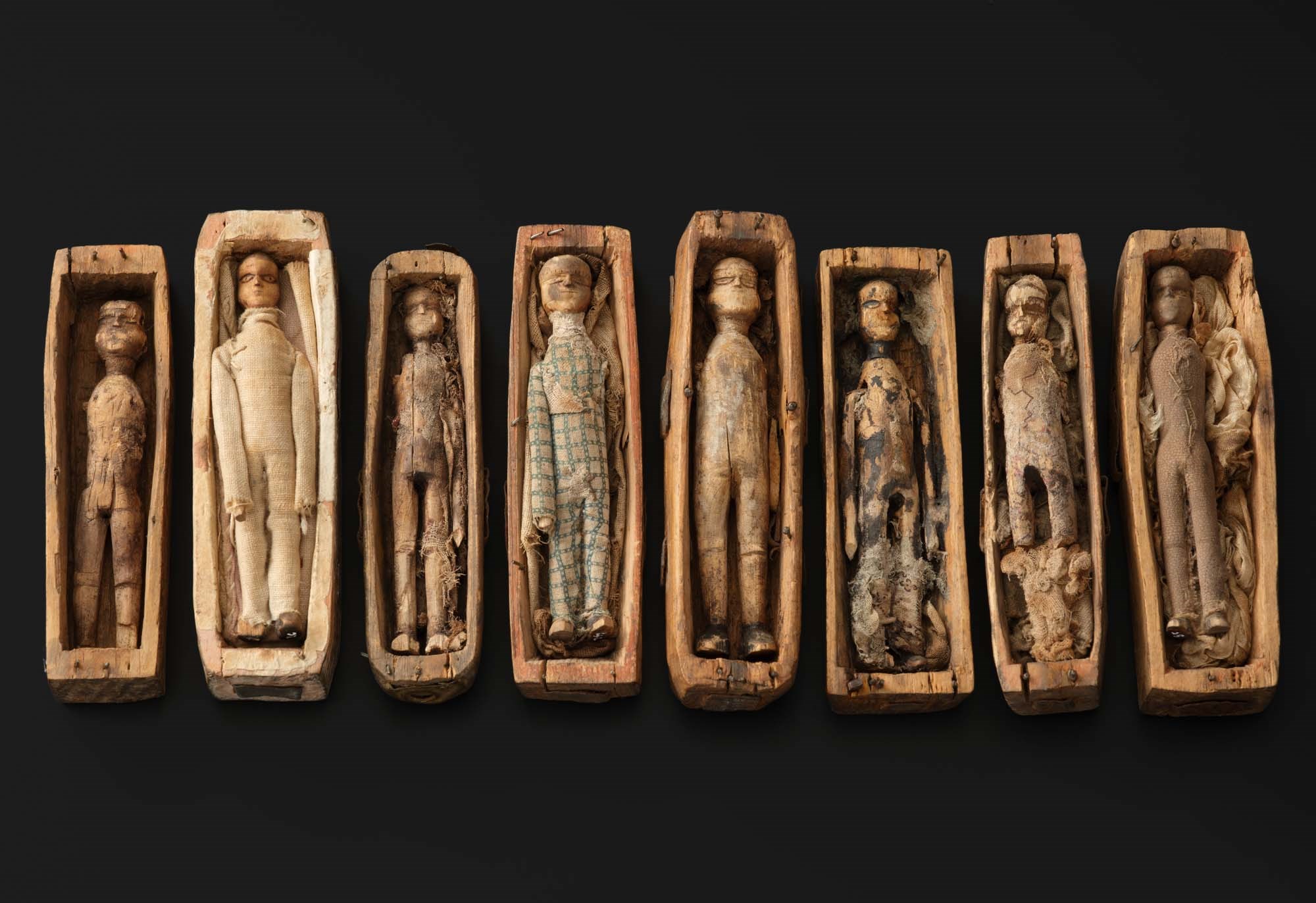
Satanic spell, superstitious charm or echo of Edinburgh’s grisly underworld history? We examine the theories put forward to explain the strange tale of these tiny coffins, discovered on Arthur’s Seat almost 200 years ago.
In late June 1836, a group of boys headed out to the slopes of Arthur’s Seat in Edinburgh to hunt for rabbits. What they found there has remained a baffling mystery ever since.
In a secluded spot on the north-east side of the hill, the boys discovered a small cave in the rock, hidden behind three pointed slabs of slate. Concealed within were 17 miniature coffins.
Eight of these coffins survive to the present day, and are on display in the National Museum of Scotland. Few objects in our collection excite as much intrigue. Who made the intricate carved figures? Who did they represent? Who placed them in their secret sepulchre… and why?
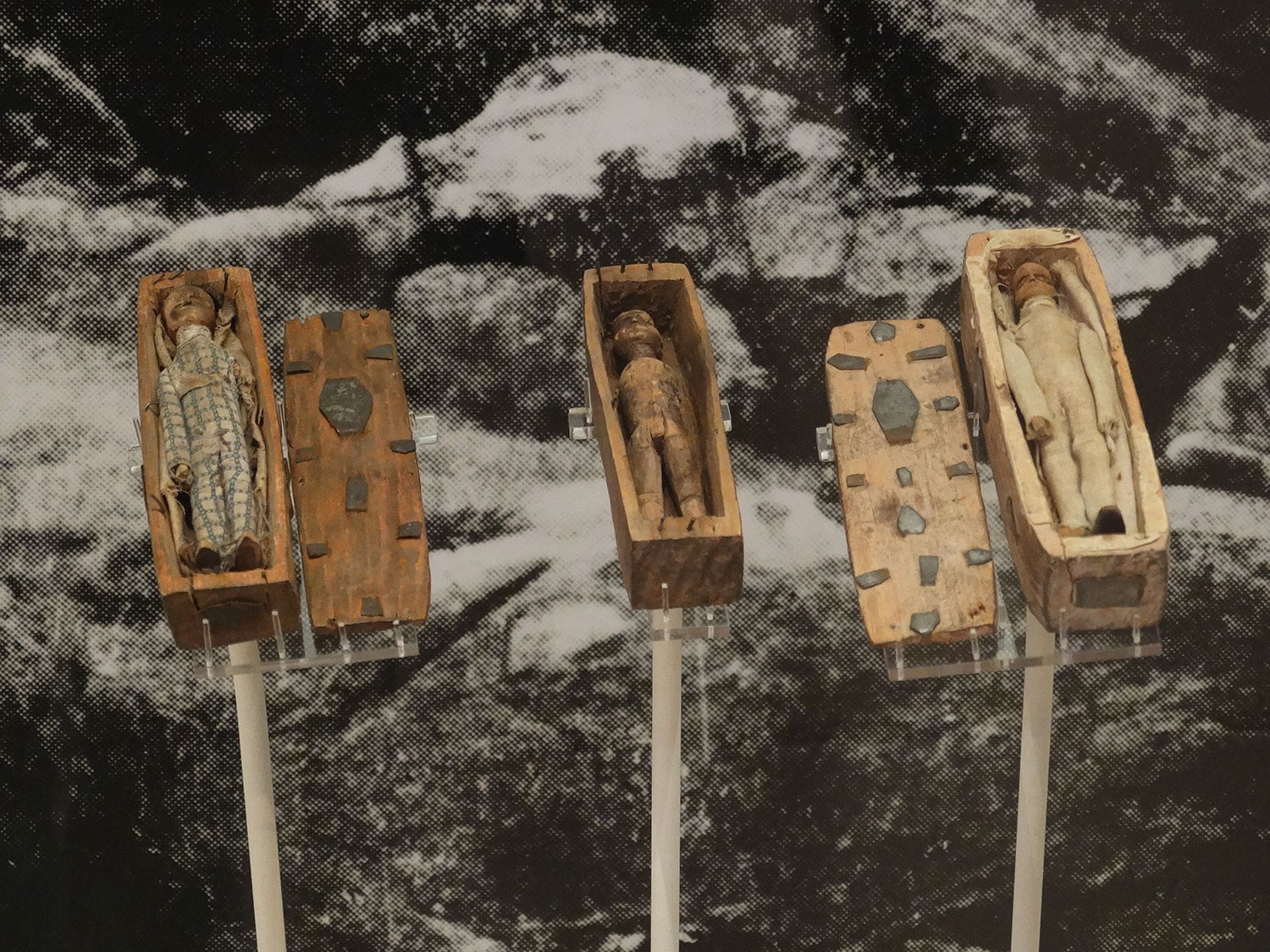
Three of the miniature coffins on display in the National Museum of Scotland.
Almost 200 years after their discovery, we attempt to unravel the mystery of the miniature coffins.
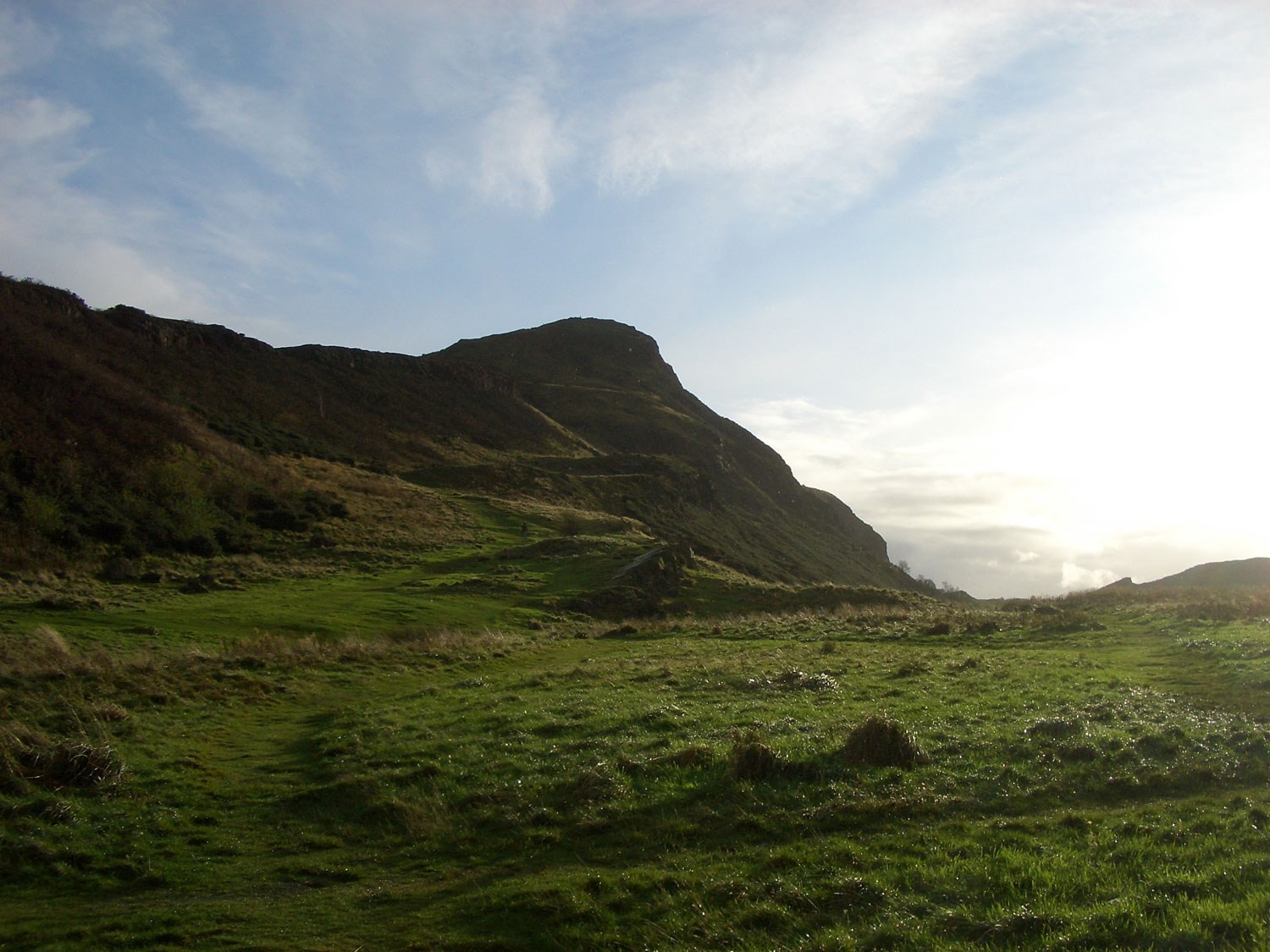
Arthur’s Seat. © Saskia Heijltjes.
The tiny coffins were arranged under slates in three tiers: two tiers of eight and one solitary coffin on the top. Each coffin, only 95mm in length, contained a little wooden figure, carved and dressed in custom-made clothes that had been stitched and glued around them.
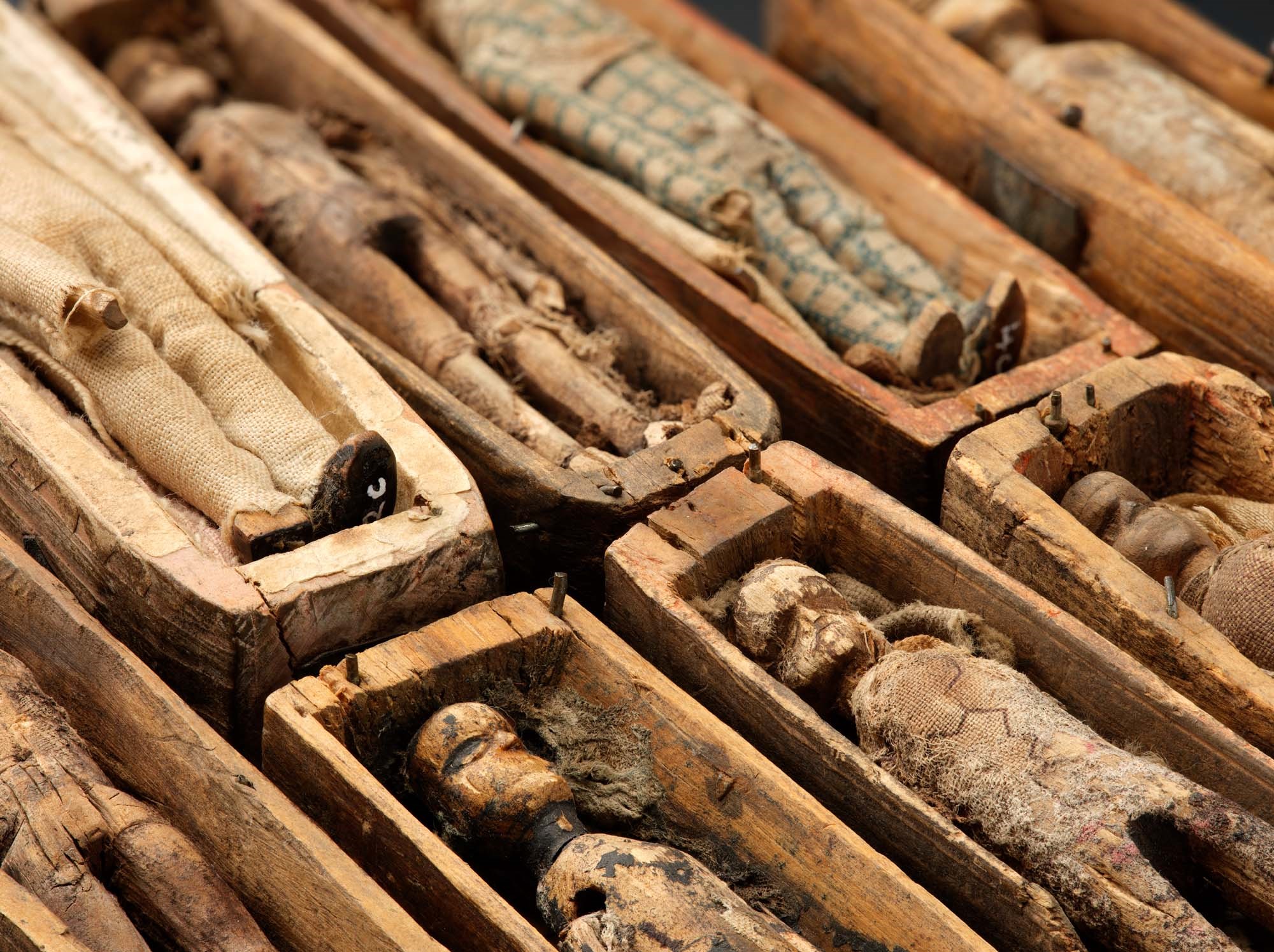
Close-up showing the detailing the carving and clothing of the Arthur's Seat Coffins.
What were they doing there? The newspapers of the time fell on the story, and each had a different theory.
"Satanic spell-manufactory!" cried The Scotsman, the first paper to report the tale, in an article published on 16 July 1836:
"Our own opinion would be – had we not some years ago abjured witchcraft and demonology – that there are still some of the weird sisters hovering about Mushat’s Cairn [sic] or the Windy Gowl, who retain their ancient power to work the spells of death by entombing the likenesses of those they wish to destroy."
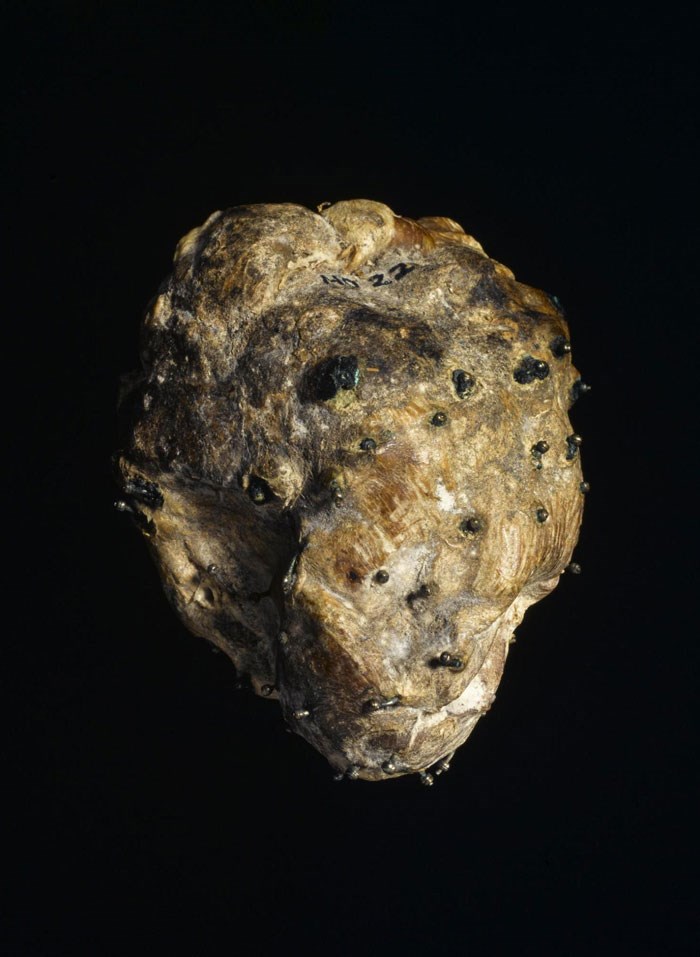
This calf’s heart stuck with pins, on display in the National Museum of Scotland, shows evidence of sympathetic magic practices being carried out in Scotland. However, x-rays have found no evidence of pins or pinholes in the Arthur’s Seat figures (H.NO 22)
A month later, the Edinburgh Evening Post proposed a more measured solution, claiming the coffins represented:
"An ancient custom which prevailed in Saxony, of burying in effigy departed friends who had died in a distant land."
The Caledonian Mercury added that:
"We have also heard of another superstition which exists among some sailors in this country, that they enjoined their wives on parting to give them “Christian burial” in an effigy if they happened [to be lost at sea]."
Yet if this is the case, why so many similar coffins? Nobody had any answers.
After this initial flurry of media interest, the Arthur's Seat coffins passed into the hands of private collectors, reappearing in 1901, when eight were donated to the Museum of the Society of Antiquaries of Scotland, and from there to National Museums Scotland. What happened to the remaining nine? The Scotsman tells us that "a number" were destroyed by the boys, although we don’t know how many – certainly no more have come to light since.
On surveying the evidence from The Scotsman, Edinburgh Evening Post and Caledonian Mercury, cuttings from which were donated with the coffins, the Society concluded that "the intention [of the coffins] seems to be to symbolise honorific burial".
But the mystery has not been allowed to rest there.
Five years later, in 1906, The Scotsman published another bizarre story about the coffins. A ‘lady residing in Edinburgh’ had told the paper that her father (‘Mr B.’) had sometimes been visited at his business premises by a ‘daft man’. On one occasion, the man had drawn on a piece of paper a picture of three small coffins, with the dates 1837, 1838 and 1840 written underneath.
"In the autumn of 1837, "The Scotsman explains, "a near relative of Mr B’s died; in the following year a cousin died and in 1840 his own brother died. After the funeral, the daft deaf mute appeared again, walked into Mr B’s office and 'glowering' at him vanished never to return."
"Is it not just possible," the article goes on to ask, "that this man was the maker of the Arthur’s Seat coffins, "driven mad by the loss of his treasures" ? Or was the whole story "nothing but coincidences"?
A weird twist to the tale indeed.
Fast-forward to 1976 and Walter Hävernick, the Director of the Museum of Hamburg History, had come up with a new theory. Referring to a German seafaring superstition of keeping mandrake roots or dolls in tiny coffins as talismen, he postulated that the coffins were a hoard of lucky charms, hidden in the hillside by a merchant, to be sold to sailors.
But while the use of charms persisted in Scotland well into the 19th century, no evidence of this particular seafaring tradition has been found.
The Scottish charms below can be seen alongside the Arthur’s Seat coffins in the National Museum of Scotland.
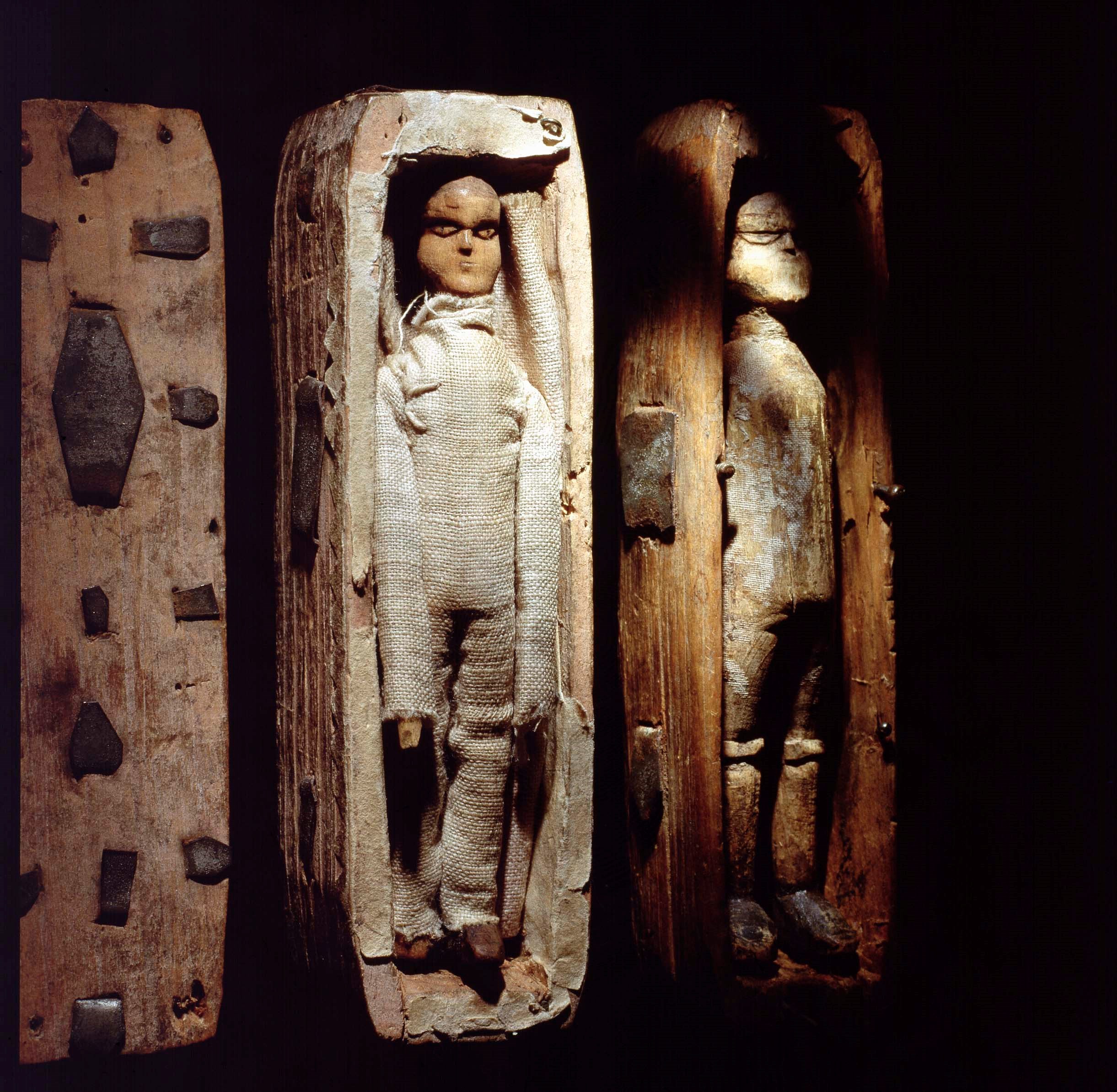
You can read their full research findings in the National Museum of Scotland Research Library.
So we know where the bodies came from and when they were buried… but what do they represent? Perhaps to understand the mystery more fully, we need to step back in time, to early 19th-century Edinburgh…
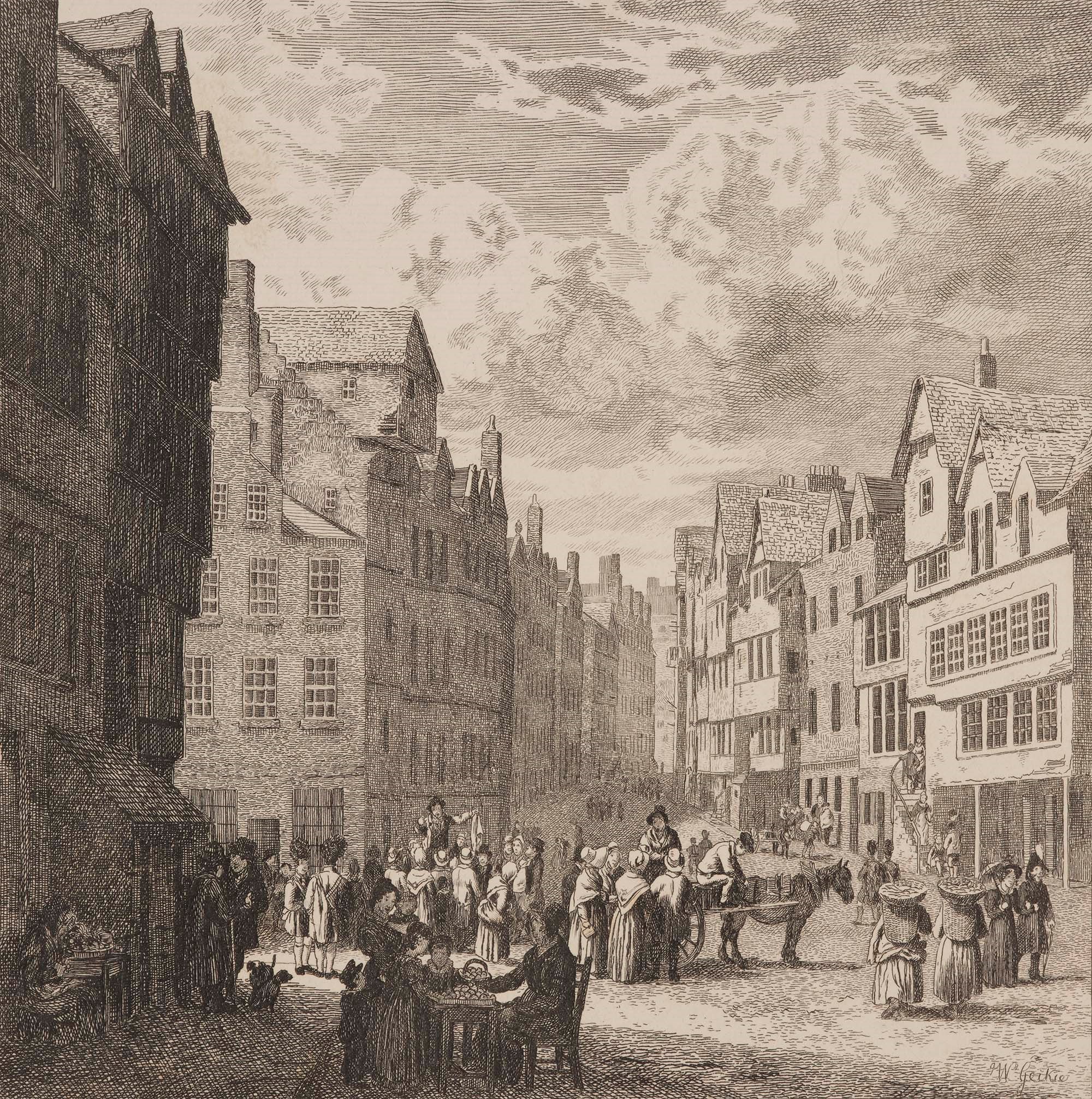
Edinburgh Old Town in the 1760s.
Celebrated as the seat of the Scottish Enlightenment, transformed by the creation of the Georgian New Town and, in 1822, graced by the first visit of a reigning monarch since 1650, Edinburgh had much to boast about in the early 19th century.
Yet this bright, sophisticated, intellectual hotbed of a city also had a dark side, highlighted by the sharp division between the elegant, well-to-do New Town and the more densely populated, overcrowded Old Town.
“To look over the South Bridge and see the Cowgate below full of crying hawkers, is to view one rank of society from another in the twinkling of an eye.- Robert Louis Stevenson, Edinburgh: Picturesque Notes (1879)
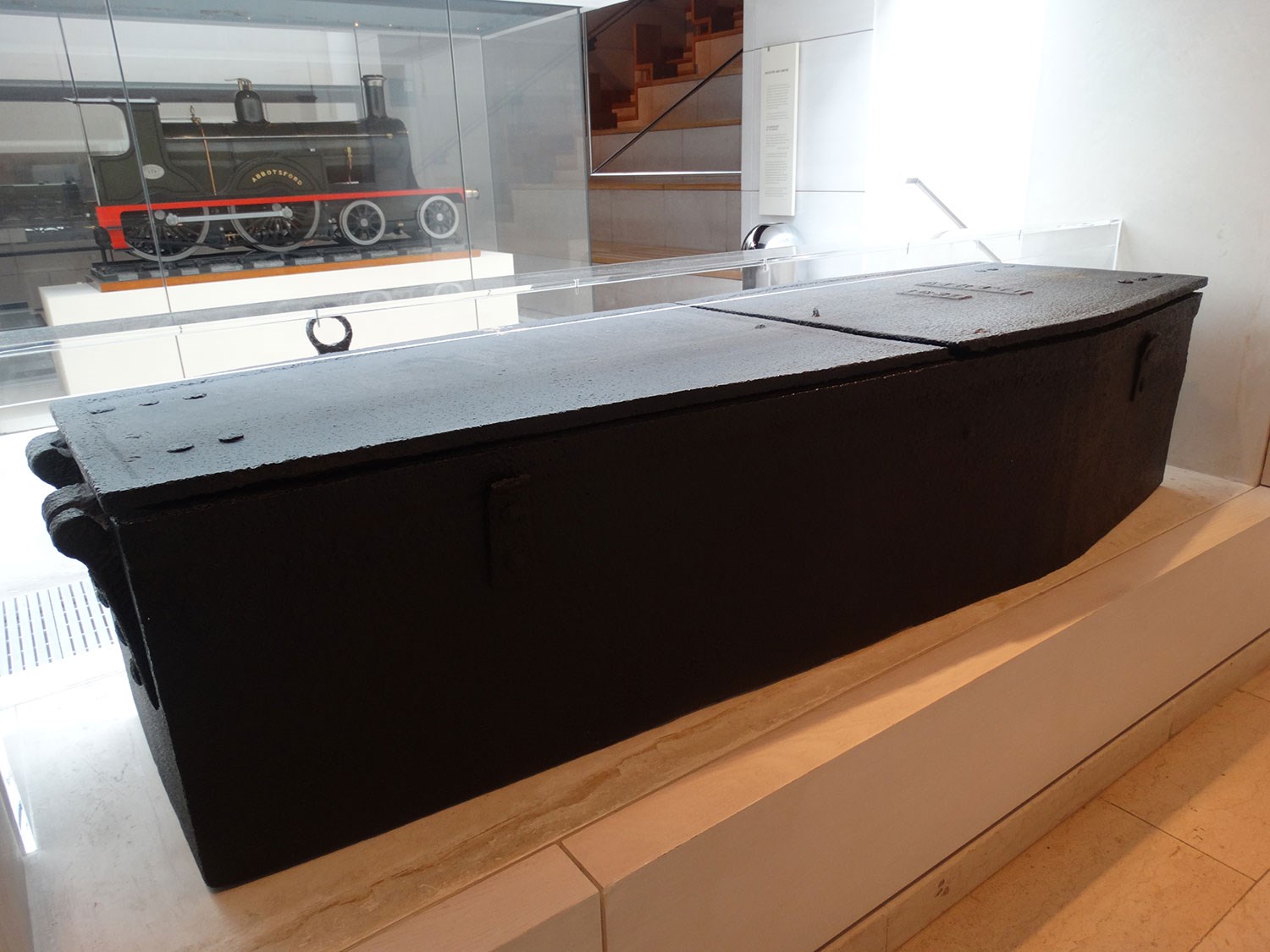
Mortsafe from Airth, Stirlingshire, 1831, currently on display in Anatomy: A Matter of Death and Life exhibition at the National Museum of Scotland. Grieving relatives, desperate to protect their dead from the ‘resurrectionists’, would encase coffins in locked iron mortsafes for the first six weeks after burial. Those who couldn’t afford the cost would set up vigil in the graveyard instead. (H.1993.567)
By the early 1800s, Edinburgh was renowned as a centre of medical excellence, its reputation as a place to study the healing arts second to none. Key to this education was an understanding of anatomy – yet a vital component of its study was becoming increasingly hard to come by for staff at the city’s medical schools: cadavers for dissection. With more and more students thronging the anatomy theatres and fewer criminals meeting their end on the gallows (the usual source of bodies for the dissecting table), the supply was no longer meeting the demand.
Unscrupulous criminals saw a gap in the market, and the practice of ‘bodysnatching’ – digging up dead bodies from churchyards and selling them to anatomists – soon became rife across the country.
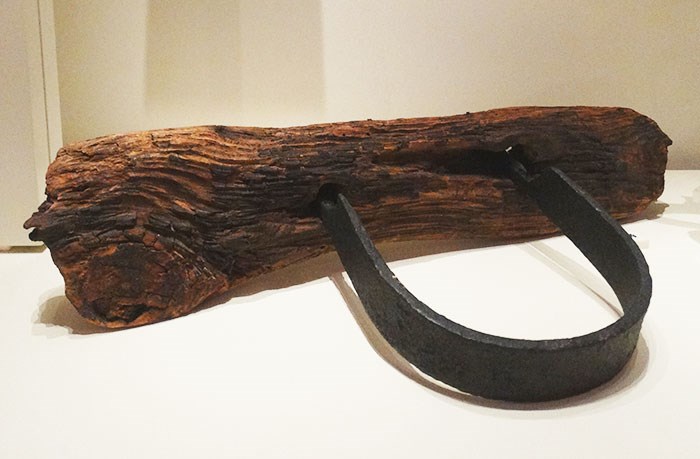
This iron collar, from Kingskettle in Fife, was bolted through the bottom of a coffin and around the neck of a corpse, to prevent it being removed by resurrectionists. c. 1820.
Yet the corpses sold by the infamous ‘bodysnatchers’ Burke and Hare to the renowned Edinburgh anatomist and lecturer Dr Robert Knox came not from grave robbing but from murder.
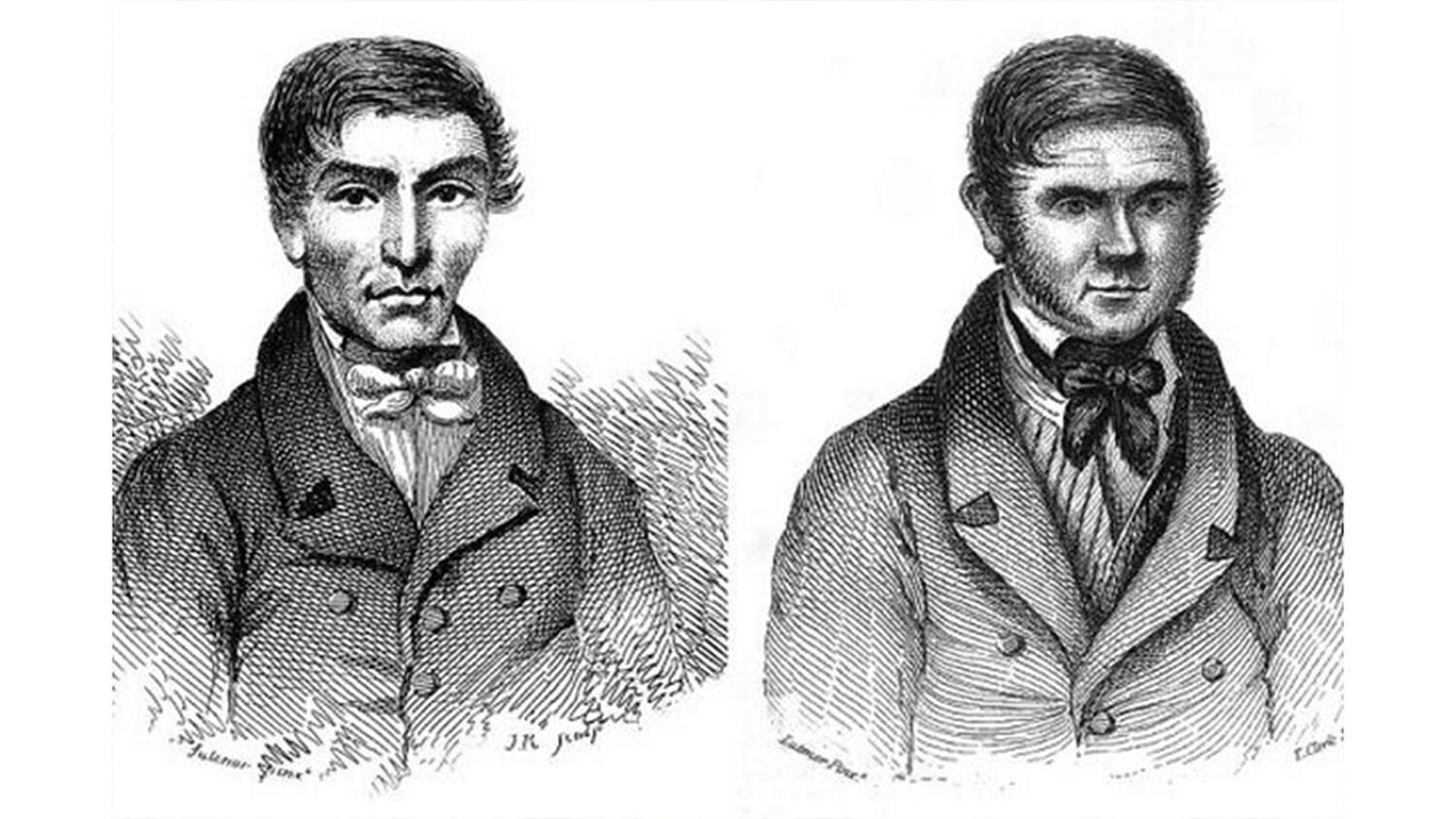
Willliam Hare and William Burke.
Irish immigrants Burke and Hare began their murderous career almost by accident, when an elderly lodger in Mrs Hare’s boarding house in the West Port died, owing money. To recoup the losses, Burke and Hare sold the body to Dr Robert Knox, for use in his anatomy school in Surgeons Square.
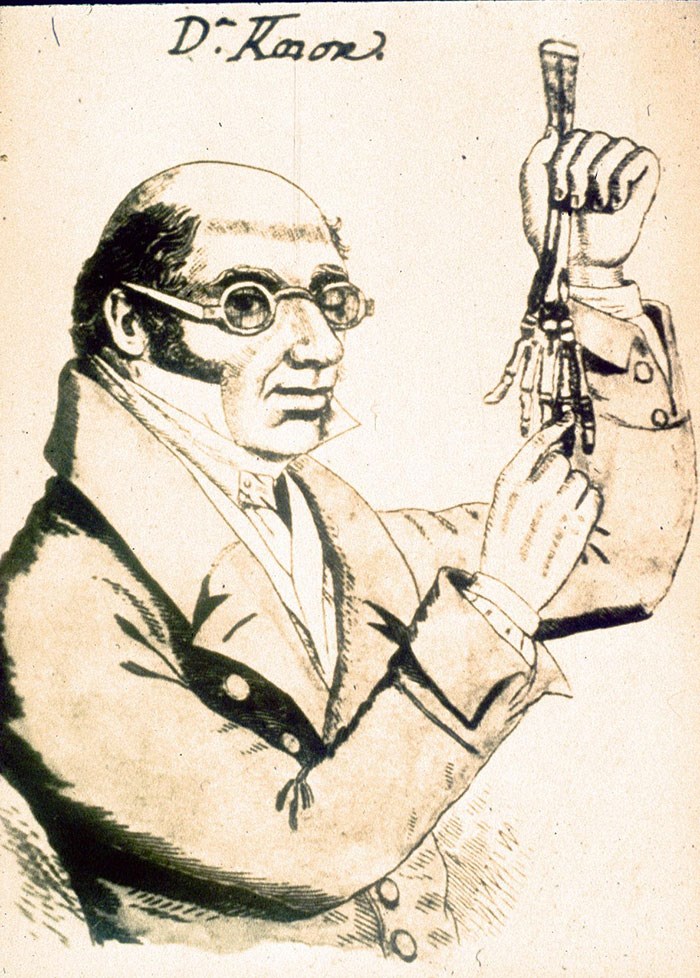
The flamboyant lecturer and anatomist Dr Robert Knox. Although Knox was cleared of any criminal activity, his association with Burke and Hare ruined his career. Image © Surgeons’ Hall Museums at The Royal College of Surgeons of Edinburgh.
And so began a vicious killing spree that lasted 10 months, during which Burke and Hare murdered at least 16 victims and earned around £150-£250,000 in today's money. At first they chose their victims carefully, choosing travellers who were unlikely to be missed, but as time went by the pair got sloppy, killing local figures who were instantly recognisable when dissection was about to take place.
“Up the close and doun the stair, But and ben wi' Burke and Hare. Burke's the butcher, Hare's the thief, Knox the boy that buys the beef.- 19th-century Edinburgh skipping rhyme
It was only a matter of time before the law caught up with them, and in November 1828, the murderous duo were arrested. Due to lack of evidence, a conviction could only be secured if one of the suspects would accept and offer to turn King's evidence and confess in return for immunity from prosecution. Burke's partner Helen McDougal and Mrs Hare refused and the offer was then made to Hare who accepted. 9.30am on Christmas morning, 1828, Willaim Burke was found guilty of murder. On 28 January 1829, he was hanged in Edinburgh’s Lawnmarket before a crowd of thousands.
The day after William Burke was hanged, his body was taken to the anatomy room of the University of Edinburgh. There Alexander Monro dissected and lectured upon his brain. To calm the unrest from the many students and townspeople unable to attend the dissection, Burke's body was laid on the dissection table while students filed past that afternoon. Thousands of the public were admitted the next day.
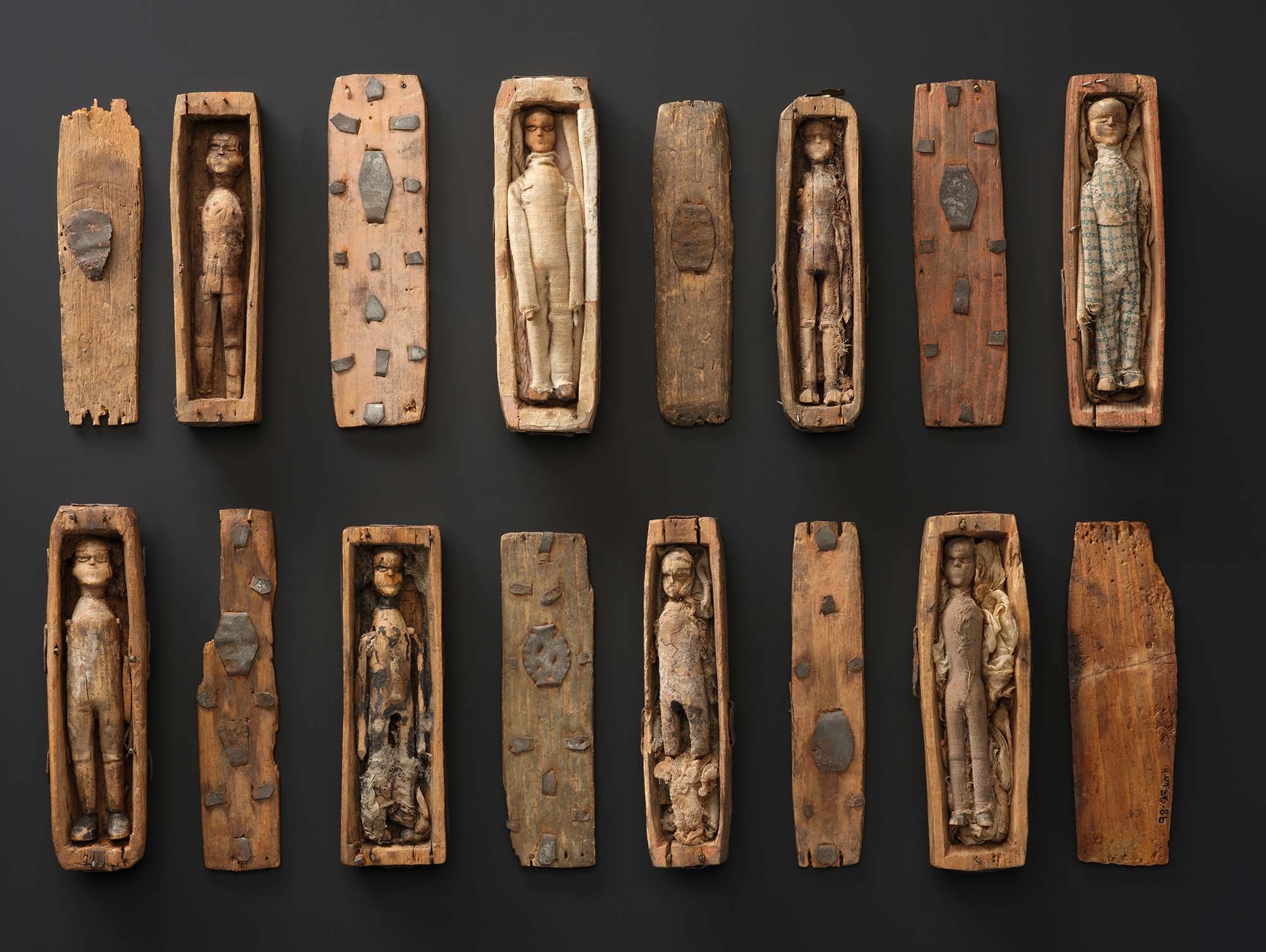
But what has this murderous tale to do with our story?
Seventeen coffins, seventeen victims; buried just a few years after Burke and Hare’s sensational story had hit the headlines. Could the coffins’ secret interment represent a substitute burial for the poor, friendless souls dispatched by the murderous pair?
While twelve of Burke and Hare’s victims were female, the corpses in the coffins are all dressed as men, but perhaps the figures were simply meant as symbols.
And yet, if they were, who buried them? Someone close to the murders, or a sympathetic onlooker? We’ll never know.
Since the coffins found their way into the museum collections, they have been on display almost constantly, and continue to fascinate visitors today. One such visitor was the author Ian Rankin, who references the coffins in his Inspector Rebus thriller The Falls (2001).
In the introduction to the book, he explains how a member of staff alerted him to their presence:
"Plenty of people over the years have come up to me with their excited notions of plots for my next book. I’ve found precious few of them to be helpful, or viable, but I was intrigued by these ‘little dolls’… which is how I made the acquaintance of the Arthur’s Seat coffins… As soon as I saw them, I knew they would make a great story, especially as no one had come up with an incontrovertible interpretation of their meaning. In other words, there was a story to tell about them…"
In 2006, the novel was adapted for television and replicas of the coffins were made for filming. The replicas can normally be seen in the Scotland: A Changing Nation Gallery in the National Museum of Scotland, but they occasionally replace the originals when they're needed for display elsewhere
“You should take a look at the little dolls, Mr Rankin.- Ian Rankin, Introduction to The Falls
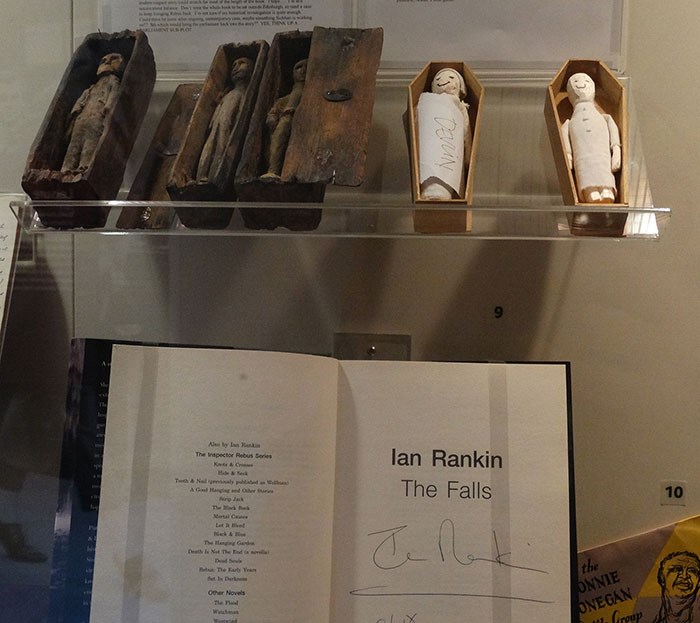
The replica coffins created for the TV adaption of The Falls (left) are bigger than the real coffins. In the novel, a serial killer places similar coffins (right) near the scenes of his crimes.
In December 2014, the Museum received a mysterious package: a beautifully-made replica of one of the coffins, cryptically entitled ‘XVIII?’
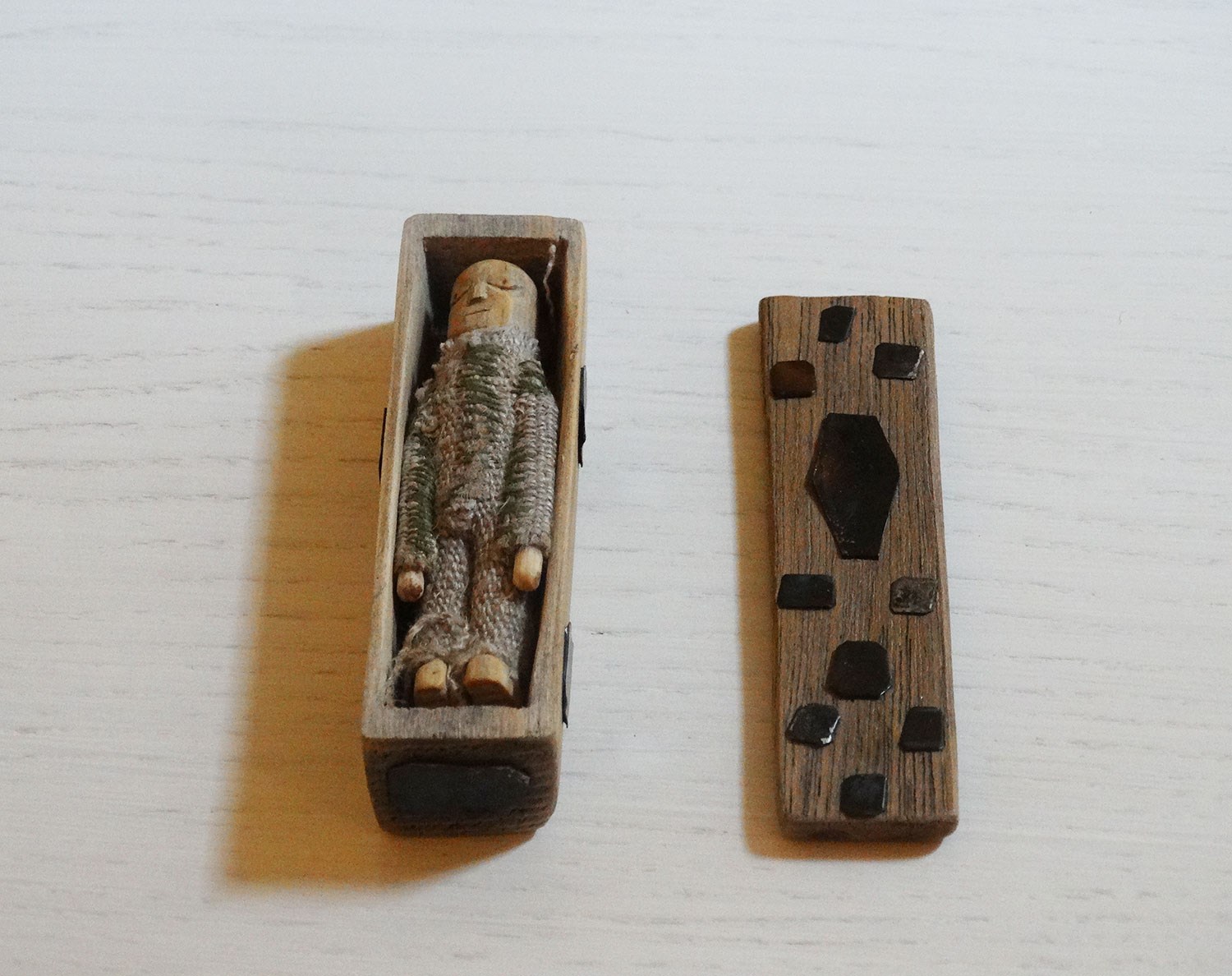
Coffin no. XVIII?
Attached was a label, quoting the chilling climax of Robert Louis Stevenson’s short story ‘The Body Snatcher’ (1884), which weaves elements of the Burke and Hare story into a chilling supernatural tale.
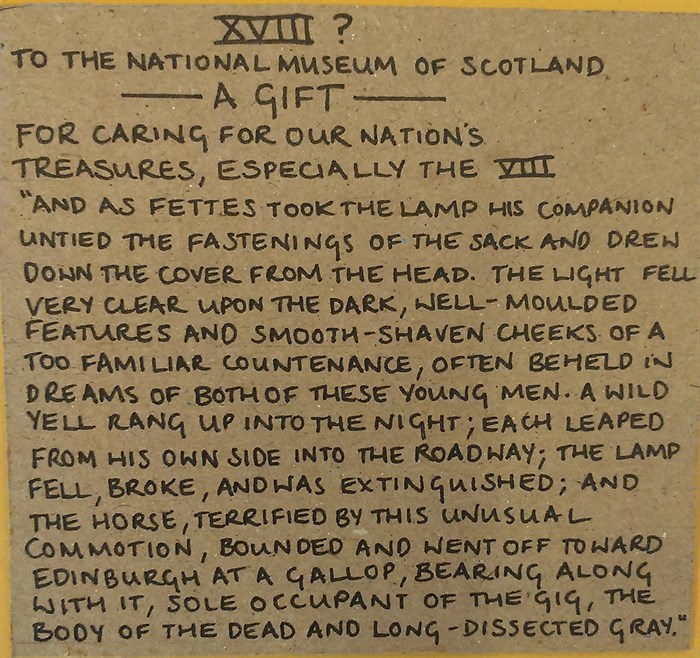
The label attached to the replica coffin.
And so the story stands: a mystery that will probably never be unravelled, but which has captured the imagination of countless visitors to the National Museum of Scotland.
Dead and buried? Not quite.
Simon Ray, the Creative Director at the Edinburgh Film Company produced a short video in response to the mystery of the Arthur's Seat Coffins. In Simon's own words:
"Like so many others, I was intrigued by these coffins from the moment I saw them on display in the National Museum. Their dark mystery seems to pull on our own fears and projections. I wanted to explore the story of their discovery, the theories and ongoing research in a textural way in keeping with their eerie mystery. This is one of a series of experimental short films responding to Edinburgh’s Miniature Coffins."
Watch Simon's video Edinburgh's miniature coffins below.